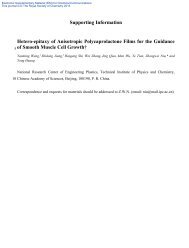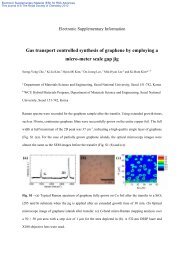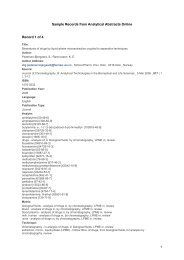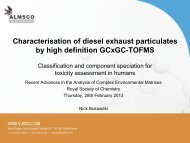Supporting Information - Royal Society of Chemistry
Supporting Information - Royal Society of Chemistry
Supporting Information - Royal Society of Chemistry
You also want an ePaper? Increase the reach of your titles
YUMPU automatically turns print PDFs into web optimized ePapers that Google loves.
Electronic Supplementary Material (ESI) for Energy & Environmental Science<br />
This journal is © The <strong>Royal</strong> <strong>Society</strong> <strong>of</strong> <strong>Chemistry</strong> 2013<br />
<strong>Supporting</strong> <strong>Information</strong><br />
Enhanced Conduction and Charge-Selectivity by N-Doped<br />
Graphene Flakes in the Active Layer <strong>of</strong> Bulk Heterojunction<br />
Organic Solar Cell<br />
Gwang Hoon Jun, a Sung Hwan Jin, a Bo Hyun Kim, a Weon-Sik Chae, b Soon Hyung Hong* a and<br />
Seokwoo Jeon* a<br />
a Department <strong>of</strong> Material Science & Engineering, Graphene Research Center (GRC),<br />
KAIST Insti-tute for the Nano-century, Korea Advanced Institute <strong>of</strong> Science and Technology<br />
(KAIST), 291 Daehak-ro, Yuseong-gu, Daejeon 305-701, Korea<br />
b Gangneung Center, Korea Basic Science Institute, Gangneung 210-702, Korea<br />
KEYWORDS graphene, nitrogen doping, organic photovoltaic, bulkheterojunction
Electronic Supplementary Material (ESI) for Energy & Environmental Science<br />
This journal is © The <strong>Royal</strong> <strong>Society</strong> <strong>of</strong> <strong>Chemistry</strong> 2013<br />
Fig. 1 XPS spectra <strong>of</strong> N (1s) peaks. High resolution N (1s) spectra <strong>of</strong> RGO by reduced in NH3 at different temperatures. 300 ºC (a), 500<br />
ºC (b) and 700 ºC (c). Pyridinic N (Np)/ quaternary N (Nq) ratio in reduced graphene as a function <strong>of</strong> the thermal reduction temperature. (d)<br />
Fig. S1 shows high-resolution N1s XPS analysis <strong>of</strong> the bonding configurations <strong>of</strong> N atoms in reduced graphene oxide<br />
with various heat-treatment temperatures. Each N1s peak was resolved into three peaks: the lowest energy peak near<br />
398.8~399.1 eV corresponded to pyridinic N (N pyri ), and the energy peak at 400.5~400.7 eV represented quaternary N<br />
(N qua ). R1,R2 It is well known that only N qua improves the electroconductivity <strong>of</strong> graphene films. N pyri , with its localized lone<br />
pair <strong>of</strong> electrons (Fig. S1d, inset atomic structures), inevitably is accompanied by vacancy defects and cannot contribute to<br />
the recovery <strong>of</strong> the graphitic structure. In contrast, N qua , a secure substitution <strong>of</strong> C with N (Fig. 3(a), upper left), is known to<br />
maintain a sp2-hybridized graphitic structure; it also provides delocalized electrons to enhance electroconductivity.<br />
.
Electronic Supplementary Material (ESI) for Energy & Environmental Science<br />
This journal is © The <strong>Royal</strong> <strong>Society</strong> <strong>of</strong> <strong>Chemistry</strong> 2013<br />
Fig. S2 Work functions <strong>of</strong> (a) undoped RGO and (b) nitrogen doped N-RGO determined by UPS measurements with He I (hv =21.2 eV)<br />
source.<br />
From the UPS spectra, the work function was taken as the difference in energy level between the inelastic cut<strong>of</strong>f and the<br />
Fermi edge. The calculated work function <strong>of</strong> undoped RGO was Φ = 21.2 eV − (21 eV − 4.6 eV) = 4.8 eV, and that <strong>of</strong> N-<br />
RGO was Φ = 21.2 eV − (21.4 eV − 5 eV) = 4.4 eV.
Electronic Supplementary Material (ESI) for Energy & Environmental Science<br />
This journal is © The <strong>Royal</strong> <strong>Society</strong> <strong>of</strong> <strong>Chemistry</strong> 2013<br />
Fig. S3 I – V characteristics <strong>of</strong> a) P3HT only and b) PCBM only devices (insets : logarithmic scales )<br />
To investigate the effect <strong>of</strong> the increase in charge-carrier mobility caused by the incorporated N-RGO, we characterized<br />
mobility using the Mott–Gurney law R3, R4 :<br />
2<br />
9 V<br />
J εrε0<br />
μ<br />
(R1)<br />
3<br />
8 L<br />
where ε r is the relative dielectric constant, ε 0 is the permittivity <strong>of</strong> the free space, µ is the charge-carrier mobility, V is the<br />
applied voltage, and L is the thickness <strong>of</strong> the device. The electron mobility increased by ~74% (3.1 × 10 −7 to 5.4 × 10 −7 m 2<br />
V −1 s −1 ). This improvement in the mobility resulted from the fact that the graphenes acted as effective charge-carrier<br />
pathways due to their high electrical conductivity.
Electronic Supplementary Material (ESI) for Energy & Environmental Science<br />
This journal is © The <strong>Royal</strong> <strong>Society</strong> <strong>of</strong> <strong>Chemistry</strong> 2013<br />
Fig. S4 Current density–voltage (I–V) characteristics <strong>of</strong> devices without light illumination (dark state).<br />
To confirm the tendency toward increased leakage current from samples with overweight concentrations <strong>of</strong> N-RGO, we<br />
performed I–V characterization without light illumination. Ideally, a solar cell without light illumination has no current<br />
density with a negative voltage due to the properties <strong>of</strong> the donor–acceptor junction. However, a device using N-<br />
RGO/P3HT:PCBM exhibited some leakage current. In contrast, a device using P3HT:PCBM showed no current with a<br />
negative voltage. This leakage current could affect the diode behavior and decrease the FF and PCE.
Electronic Supplementary Material (ESI) for Energy & Environmental Science<br />
This journal is © The <strong>Royal</strong> <strong>Society</strong> <strong>of</strong> <strong>Chemistry</strong> 2013<br />
Fig. S5 Normalized fluorescence-lifetime curve <strong>of</strong> P3HT : PCBM (blue line) and incorporated 0.5 wt% <strong>of</strong> N-RGO (red line).<br />
Fig. S5 shows the normalized fluorescence decay curves <strong>of</strong> P3HT:PCBM and 0.5 wt% N-RGO/P3HT:PCBM. No<br />
significant change was observed in the lifetime by incorporation <strong>of</strong> N-RGO (0.235 ± 0.001, n.s., and 0.238 ± 0.002, n.s. for<br />
P3HT:PCBM and 0.5 wt% N-RGO/P3HT:PCBM, respectively).<br />
From these time-resolved PL intensity and lifetime studies, our results showed that the graphene flakes played the role <strong>of</strong><br />
charge-carrier pathways rather than exciton dissociation sites. This was verified by the PL lifetime, with no significant<br />
change observed with incorporation <strong>of</strong> N-RGO, as indicated in Fig. S5. This suggests that the work function difference <strong>of</strong><br />
donor/acceptor P3HT/PCBM is larger than that <strong>of</strong> donor/N-RGO; thus, the excitons are mainly dissociated at donor/acceptor<br />
interfaces.
Electronic Supplementary Material (ESI) for Energy & Environmental Science<br />
This journal is © The <strong>Royal</strong> <strong>Society</strong> <strong>of</strong> <strong>Chemistry</strong> 2013<br />
Table S1. Atomic concentration <strong>of</strong> graphite, GO, RGO, and N-RGO<br />
C<br />
(atomic %)<br />
O<br />
(atomic %)<br />
N<br />
(atomic %)<br />
C/O<br />
ratio<br />
Graphite 99.44 0.56<br />
GO 63.18 32.65 1.55 1.94<br />
RGO 88.78 11.22 - 7.91<br />
N-RGO 86.52 5.19 7.44 16.67<br />
Table S2. Proportion <strong>of</strong> N-P and N-Q with various thermal reduction temperatures<br />
N-P (%) N-Q (%)<br />
Ratio<br />
(Nq/Np)<br />
300 o C 75 25 0.33<br />
500 o C 33 66 1.98<br />
700 o C 49 51 1.01<br />
Table S3. Photovoltaic parameters <strong>of</strong> OPV cells <strong>of</strong> RGO/P3HT:PCBM and N-RGO/P3HT:PCBM in this work<br />
J SC [mA/cm 2 ] V OC [V] FF PCE [%]<br />
Pristine<br />
P3HT:PCBM<br />
10.54 ± 0.11 0.58 ± 0.01 0.51 ± 0.01 3.12 ± 0.07<br />
RGO 0.1wt% 12.69 ± 0.31 0.53 ± 0.01 0.40 ± 0.01 2.71 ± 0.17<br />
RGO 0.5wt% 7.37 ± 0.29 0.54 ± 0.01 0.40 ± 0.01 1.61 ± 0.09<br />
RGO 1wt% 6.57 ± 0.10 0.45 ± 0.01 0.38 ± 0.01 1.06 ± 0.03<br />
N-RGO 0.1wt% 12.96 ± 0.41 0.56 ± 0.01 0.50 ± 0.01 3.65 ± 0.19<br />
N-RGO 0.5wt% 14.86 ± 0.09 0.58 ± 0.01 0.50 ± 0.01 4.39 ± 0.09<br />
N-RGO 1wt% 14.86 ± 0.58 0.58 ± 0.02 0.46 ± 0.03 4.06 ± 0.29<br />
Table S4. Charge carrier motilities: PCBM-only devices (electron) and P3HT-only devices (hole). The concentration <strong>of</strong> graphene is 1 wt%<br />
Electron mobility<br />
(PCBM only devices)<br />
(m 2 V −1 s –1 )<br />
Hole mobility<br />
(P3HT only devices)<br />
(m 2 V −1 s –1 )<br />
without graphene 3.1×10 -7 7.3×10 -8<br />
RGO 3.2×10 -7 5.6×10 -8<br />
N-RGO (1 wt%) 5.4×10 -7 4.4×10 -8
Electronic Supplementary Material (ESI) for Energy & Environmental Science<br />
This journal is © The <strong>Royal</strong> <strong>Society</strong> <strong>of</strong> <strong>Chemistry</strong> 2013<br />
References<br />
R1 X. L. Li, H. L. Wang, J. T. Robinson, H. Sanchez, G. Diankov and H. J. Dai, J Am Chem Soc, 2009, 131, 15939-15944.<br />
R2 H. M. Jeong, J. W. Lee, W. H. Shin, Y. J. Choi, H. J. Shin, J. K. Kang, and J. W. Choi, Nano Lett., 2011, 11, 2472-<br />
2477<br />
R3 V. D. Mihailetchi, J. K. J. van Duren, P. W. M. Blom, J. C. Hummelen, R. A. J. Janssen, J. M. Kroon, M. T. Rispens,<br />
W. J. H. Verhees, M. M. Wienk, Adv. Funct. Mater., 2003, 13, 43-46.<br />
R4 S. Scheinert, W. Schliefke, Synt. Met., 2003, 139, 501-509.















